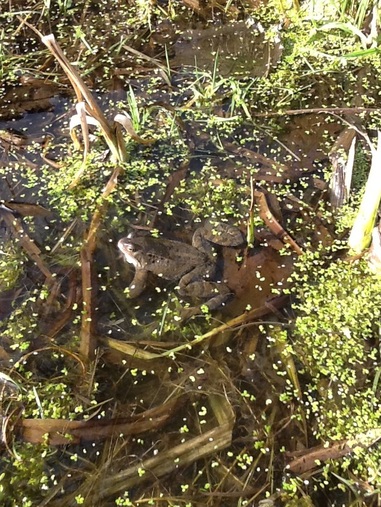|
Friday 6th March, our first warm day and the sun shining – glancing out of my studio window as I was teaching I caught a ripple of movement in the pond. I looked more carefully. The surface of the water was broken by a multitude of heads, shining in the sun, some decorated with duck weed. The frogs have arrived, and now the orchard is full of the sound of croaking. They arrived with the full moon of March, and at last spring is on the way.
0 Comments
Last week I went with my art group to visit Hillside Cottage in Windley, Derbyshire, the home of artist and engraver, Rosalind Bliss. Beyond Turnditch, a few miles from home, the road from Ashbourne to Belper seemed to form a boundary – dry-stone walls gave way to hedges, buildings built of brick instead of limestone, the hills more rounded, with deep, tree-filled valleys, so the whole landscape appeared softer, less stark. We reached a dip in the road and there was Hillside Cottage, with its white rendered walls and blue paintwork, towering topiary and undulating yew hedge sheltering the front windows, and a garden full of snowdrops sloping down the valley looking towards Gunhills. This lovely house was the holiday home, and later permanent home, of Rosalind’s parents, artists Douglas Percy Bliss and Phyllis Dodd, both successful and acclaimed painters before the war. Douglas Bliss was for many years the director of Glasgow School of Art, as well as an authority on the history of wood engraving. As we wandered around the garden and the ancient orchard beyond it, we came face to face with strange and humorous heraldic beasts, reminiscent of children’s writer, Maurice Sendak’s Wild Things, and a little further on a pig, cast in concrete escaping through a brick wall, all created many years ago by Douglas Bliss after his retirement.
We entered a small low room decorated in frayed silvery wallpaper. Sunlight filtered through the plants in the window and over the table, lighting up a china teacup filled with snowdrops and purple crocuses, and a selection of art books – the work of Ravilious and Bawden, beautifully bound in block printed paper. The walls were hung with paintings by Rosalind’s parents – portraits by her mother, Phyllis Dodd, and landscapes by her father. There was so much to look at in such a small space. I was struck by an exquisite full-length portrait of Douglas Bliss as a young man wearing a brown suit and shiny brown shoes, leaning in a doorway, looking down at his feet, and bathed in yellow light. ‘It was my mother who persuaded my father to take up painting again,’ Rosalind told us, as she showed us his painting of a wintery garden in Blackheath, pathways and formal beds under snow, dark trees in the distance – the quiet gloom of January. ‘It was painted during the Phoney War when the snow came. That’s me in the pram. Blackheath has completely changed now, there are houses where those gardens used to be. The war changed everything.’ Rosalind was trained as a mural painter, but as ‘nobody wants murals’, she began painting screens. They are stacked in her studio across the yard, and she unfolded one after another to show us – the interior of a French church with golden arches and pillars disappearing into the distance, the rich blues and purples of Samarkand, part painted, part lino cut, a summer field gloriously abundant with daisies. It was when she showed us two small engravings by her mother of Northgate St in Chester, one looking towards the Pied Bull pub, and another taken from the canal (both scenes I know well), that we became aware of an amazing coincidence. Phyllis Dodd had spent her childhood in Chester. I asked Rosalind where her mother had lived. ‘Lumley Rd,’ she replied. ‘My father built number 13.’ 15 Lumley Rd is the house I’ve known all my life, the house my sister was born in, and where my parents, now in their late 80s, have lived for fifty-six years. When I stand at the window of my old bedroom, I look across the back garden at the domineering red-brick wall and green stained glass window of number 13, and watch the crows on the chimney pots. Phyllis Dodd left this house in the late 30s, and sometime after, the new owners must have sold part of the garden to the man who built our house in 1956. It’s good to think of Phyllis Dodd as a young girl before the war, sitting with her sketch book in her garden, where my childhood home now stands – where fifty years later my sister and I sat for hours over our art homework. |
AuthorTricia Durdey dances, writes, and teaches Pilates. Archives
October 2017
|




 RSS Feed
RSS Feed